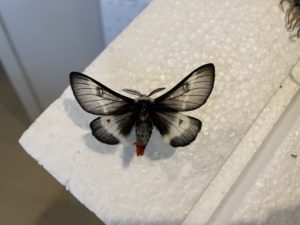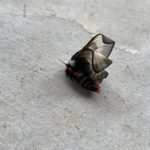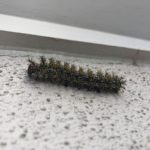
Eastern Buck Moth
You may have noticed a emergence of fluffy black colored moths flying around or flapping around on the ground.
I noticed this emergence this morning and have to believe there was something in the weather that has sparked them all to emerge from their pupal cases as adults.
These moths are none other than the adult form of those (maybe long forgotten) spiny caterpillars that we all dreaded this spring – the Eastern Buck Moth.
Adults are fluffy and are primarily black in color. They have a white band across the fore and hind wings and their abdomen is orange. They are actually really pretty moths when viewed up close. Adults are known to fly around October to November – so we are right on track – and after mating will lay their eggs in clusters. Those eggs will make it through the winter until spring, when they will hatch and the larvae will emerge again. After feeding, the larvae pupate and they remain in the pupal case until about now, when the cycle starts all over again.

Eastern Buck Moth recently emerged from pupa. Wings yet to completely unfold.
Adults do not have functioning mouthparts, so unfortunately they are not pollinating anything. Just mating, laying eggs, and dying. In the meantime, they are providing a food source for birds and other predators. I have been watching the mockingbirds chase them around the sky for a quick snack.
The larvae do have spines that are painful when touched. This is their defense mechanism against predators and unfortunate humans and dogs may be innocent victims. Their hosts are oaks and they prefer oak forests, so are more likely to be found in more rural areas, established neighborhoods with many oaks, or if you live next to an urban forest or park.
The pupa are interesting because they have been known to remain for up to two year. The Spring of 2020 was the first year I can recall seeing large numbers of the caterpillars. The Spring of 2021 everyone else seemed to notice them too, so we’ve had two years for the population to build up. If conditions are right (and who will know!), this large adult emergence may mean an above average population of caterpillars next Spring. Time will tell!

Eastern Buck Moth caterpillar
What should you do? Nothing right now. Let the birds and lizards have their Thanksgiving meals and we’ll see what happens. It is difficult to predict. However, come Spring, if you hear, see, or find them chomping on your trees and have trees you want to save, be sure to use a foliar spray and click here for more information on treatments.
Written by: Molly Keck, BCE, Senior Extension Program Specialist – Integrated Pest Management